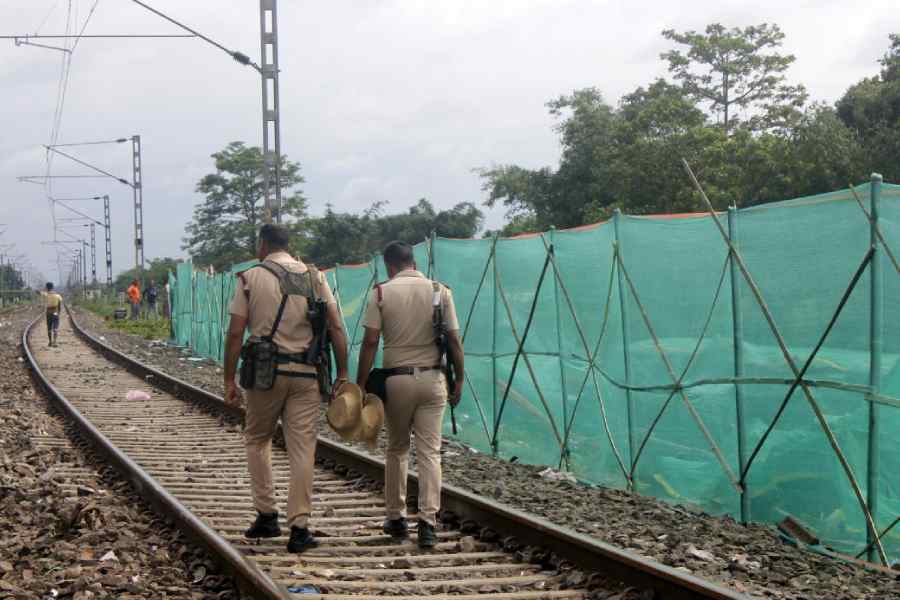A note of dissent from chief loco inspector Om Prakash Sharma in a report by senior railway officials on Monday’s Siliguri train collision has sparked fresh controversy over the attempts to blame the accident solely on the crew of the goods train, including the dead loco pilot.
The crux of the matter is whether or not the loco pilot, who was cleared to pass the malfunctioning automatic signals (which were constantly red), was set a speed limit and asked to look out for any obstruction ahead until he reached the next station.
Six senior Northeast Frontier Railway (NFR) officials have in the joint observation report (JOR) — submitted on Tuesday after visiting the accident site — charged the goods train driver with “excessive speed”, implying he had ignored the speed limit.
Sharma, the seventh member of the team, indicated the driver had been wrongly given the clearance under a different protocol that entails no speed limit, and therefore the fault lay elsewhere.
Form T/A 912 authorises a train driver to jump signals without a speed limit being set. Under Form T/D 912, the driver is prescribed a maximum speed of 25kmph after the train passes the red signal and asked to keep an eye out on the tracks ahead.
A Form T/A 912 can be issued after the stationmaster has made sure there is no other train on the same tracks between his or her station and the next. But on Monday, the Kanchenjunga Express lay in the path of the goods train between the Rangapani and Chatter Hat stations.
In the JOR, of which The Telegraph has a copy, six senior railway officials from New Jalpaiguri have primarily blamed loco pilot Anil Kumar, assistant loco pilot Manu Kumar, and train manager (guard) Bhawesh Kumar Sharma of the goods train that had rammed the Kanchenjunga from behind, killing 10 people.

GRP jawans walk near the accident site on Thursday. Picture by Passang Yolmo
While pilot Anil was killed in the accident, his assistant Manu is critically ill at a private nursing home in Siliguri. Guard Bhawesh is unhurt.
“On site observation, we the undersigned come to the conclusion that Rear end dashing of 13174 DN (Kanchenjunga Express) by the DN GFCJ container (goods train) and ultimately derailment of coaches and container wagon may occurred due to not following the rule of passing the AUTOMATIC SIGNAL at danger position and also excessive speed of train no. DN GFCJ container, loco number 43616/PADX,” the “cause of derailment” part of the report reads.
But Sharma’s dissent note said: “I don’t agree as there was a failure of all automatic/ semi-automatic signals between RNI (Rangapani) and CAT (Chatter Hat), including the Dn (down) starter and Dn advance starter (signal) of RNI since 5:50 am on 17.06.24. In this case, operating form no. T/D 912 should be issued as per SR (sub-rule) 9.12/1 and should be treated as an absolute block section (RNI-CAT).”
Treatment as “absolute block section” means no train should have been allowed to pass Rangapani as long as the train ahead had not left Chatter Hat. But this was breached with the goods train waved on while the Kanchenjunga, travelling at a slow speed, was between it and Chatter Hat.
A chief loco inspector (CLI) is the immediate supervisor of around 25-40 loco pilots. A CLI conducts inspections and counselling, offers guidance, and submits administrative and performance reports for the loco pilots who report to him or her. Usually, a senior loco pilot is promoted to a CLI.
As the joint report circulated among railway employees, they demanded that the railway authorities announce that the responsibility for the accident lay not solely on the goods train crew but on the railways collectively.
Associations of railway employees and former and current loco pilots have been expressing their discontent ever since railway board chairperson Jaya Verma Sinha, in her initial statement on Monday, said the collision happened because the goods train driver had “disregarded the signal”.
Since the day of the accident, these employees have been saying that the loco pilot had been incorrectly issued with a T/A 912 instead of a T/D 912.
“From day one, we have been claiming that the pilot of the goods train can’t be blamed before a full-fledged probe is complete, as he was given the wrong authorisation that allowed him to proceed without any speed limit,” said V.B. Singh, general secretary of the Eastern Railway Trinamool Men’s Congress.
“Now, the CLI has cited the same point in his report. We hope the railway authorities will not accuse the deceased pilot of being responsible for the accident after this dissent note.”
Surendra Kumar, the divisional railway manager (Katihar division of NFR) under whose jurisdiction the accident occurred, played it safe when asked about the authorisation form issued to the goods train driver.
Interacting with journalists at the additional divisional railway manager’s office in New Jalpaiguri, he said: “(Authority) forms are being distributed as per instruction and appropriate forms were handed over (to the loco pilots).”
Asked about the JOR, he said: “Different forms are issued for different purposes. We cannot speak further on the issue as the inquiry is in progress.”
K.C. James, secretary-general of the All India Loco Running Staff Association, said: “The dissent note of the CLI points out that there was communication between the station masters of Rangapani and Chatter Hat. In such a situation, the goods train should not have been given the go-ahead until the Kanchenjunga Express had reached Chatter Hat. In that situation, the form to be used was T/ D 912.”
The final report of the railways’ main investigation into the collision is awaited.
Amid the controversy, the Sealdah division of Eastern Railway on Wednesday issued an order suspending the issuance of the T/A 912 form till “further advice”. However, the order was withdrawn on Thursday with the explanation that it had been issued “erroneously”.
Additional reporting by Bireswar Banerjee from Siliguri










